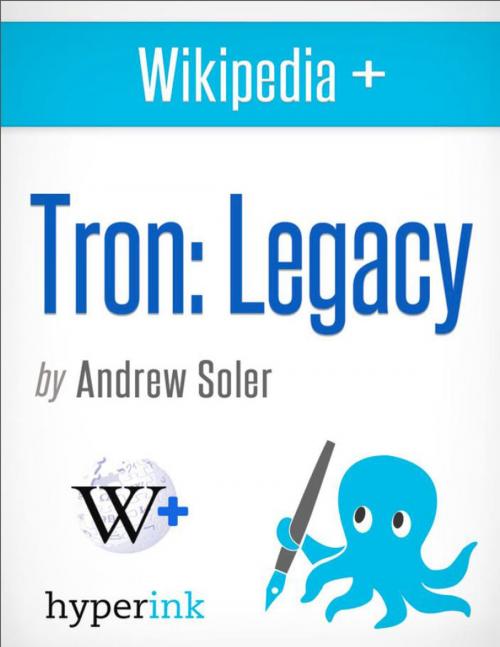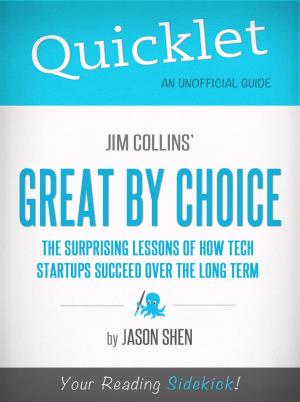Tron: Legacy - Behind the Film
Nonfiction, Reference & Language, Study Aids, Book Notes, Art & Architecture, General Art| Author: | Andrew Soler | ISBN: | 9781614649205 |
| Publisher: | Hyperink | Publication: | February 24, 2012 |
| Imprint: | Hyperink | Language: | English |
| Author: | Andrew Soler |
| ISBN: | 9781614649205 |
| Publisher: | Hyperink |
| Publication: | February 24, 2012 |
| Imprint: | Hyperink |
| Language: | English |
ABOUT THE BOOK
Marketing hype for Tron: Legacy started years before the film’s actual. At the 2008 Comic-Con in San Diego, Disney unveiled a teaser trailer for a potential Tron sequel, delighting the stunned audience. Coyly titled TR2N, the teaser created enough buzz to convince Disney executives to continue an ambitious three-and-a-half year marketing campaign. At a cost of $170 million, Tron: Legacy finally debuted on December 17, 2010, surpassing Disney’s wildest expectations and grossing a staggering $400 million worldwide.
The box office sensation mesmerized audiences with its slick, high-tech depiction of a father-son reunion in a futuristic dystopia. With Academy Award-winning actor Jeff Bridges reprising his role as Kevin Flynn and CLU, the film featured cutting-edge special effects and an electronic soundtrack by Daft Punk. With its lucrative run in theaters complete, Tron: Legacy continues to impress. Pete Hammond of Box Office Magazine observed, "Legacy's great story and acting are matched by great effects.”
MEET THE AUTHOR
Andrew Soler has published poetry and short stories while working as a newspaper journalist. After selling gas masks and chopping wood in an industrial lumberyard, he quit his job to finish college and earned a BA, Political Science. Andrew then spent five years teaching English, History and creative writing in the bay area. He is interested in provocative music, muscle cars, gritty movies and beatnik literature.
EXCERPT FROM THE BOOK
Sam’s character growth reflects the story’s thematic world. As the film progresses, Sam changes from a jaded, self-interested lone wolf into a selfless hero willing to make sacrifices to bring back his father to the real world. The moment he leaves his father’s safe house to find access to the portal -- defying his father’s wishes -- is a symbolic moment. No longer the cynical prankster who avoids his father’s business, Sam transforms into a warrior willing to take risks for freedom. Throughout the film, the ideas of selfishness and selfless sacrifice violently clash, culminating in the eerie climax when Kevin Flynn gives up his own life to prevent CLU from travelling through the portal into the real world.
Religious motifs, especially Buddhist-oriented ideas, fuel the film’s surprisingly contemplative existential tone. Like a soulful meditation during a storm of special effects and futuristic sounds –
a stylish bombardment of the senses –
the film’s underlying mood is Zen-like.
When Sam first meets his father, Kevin Flynn is in the midst of a sesshin, or intense Zen-Buddhist meditation. Even the decor of Flynn’s safe house is therapeutically minimalist, a welcome retreat from the noisy urban nightmare of the Grid. The Buddhist messages are subtle but forceful, upon closer examination –
emptiness and denial of the illusory self; meditation during turmoil and the transcendent power of selfless love...
Buy a copy to keep reading!
ABOUT THE BOOK
Marketing hype for Tron: Legacy started years before the film’s actual. At the 2008 Comic-Con in San Diego, Disney unveiled a teaser trailer for a potential Tron sequel, delighting the stunned audience. Coyly titled TR2N, the teaser created enough buzz to convince Disney executives to continue an ambitious three-and-a-half year marketing campaign. At a cost of $170 million, Tron: Legacy finally debuted on December 17, 2010, surpassing Disney’s wildest expectations and grossing a staggering $400 million worldwide.
The box office sensation mesmerized audiences with its slick, high-tech depiction of a father-son reunion in a futuristic dystopia. With Academy Award-winning actor Jeff Bridges reprising his role as Kevin Flynn and CLU, the film featured cutting-edge special effects and an electronic soundtrack by Daft Punk. With its lucrative run in theaters complete, Tron: Legacy continues to impress. Pete Hammond of Box Office Magazine observed, "Legacy's great story and acting are matched by great effects.”
MEET THE AUTHOR
Andrew Soler has published poetry and short stories while working as a newspaper journalist. After selling gas masks and chopping wood in an industrial lumberyard, he quit his job to finish college and earned a BA, Political Science. Andrew then spent five years teaching English, History and creative writing in the bay area. He is interested in provocative music, muscle cars, gritty movies and beatnik literature.
EXCERPT FROM THE BOOK
Sam’s character growth reflects the story’s thematic world. As the film progresses, Sam changes from a jaded, self-interested lone wolf into a selfless hero willing to make sacrifices to bring back his father to the real world. The moment he leaves his father’s safe house to find access to the portal -- defying his father’s wishes -- is a symbolic moment. No longer the cynical prankster who avoids his father’s business, Sam transforms into a warrior willing to take risks for freedom. Throughout the film, the ideas of selfishness and selfless sacrifice violently clash, culminating in the eerie climax when Kevin Flynn gives up his own life to prevent CLU from travelling through the portal into the real world.
Religious motifs, especially Buddhist-oriented ideas, fuel the film’s surprisingly contemplative existential tone. Like a soulful meditation during a storm of special effects and futuristic sounds –
a stylish bombardment of the senses –
the film’s underlying mood is Zen-like.
When Sam first meets his father, Kevin Flynn is in the midst of a sesshin, or intense Zen-Buddhist meditation. Even the decor of Flynn’s safe house is therapeutically minimalist, a welcome retreat from the noisy urban nightmare of the Grid. The Buddhist messages are subtle but forceful, upon closer examination –
emptiness and denial of the illusory self; meditation during turmoil and the transcendent power of selfless love...
Buy a copy to keep reading!















